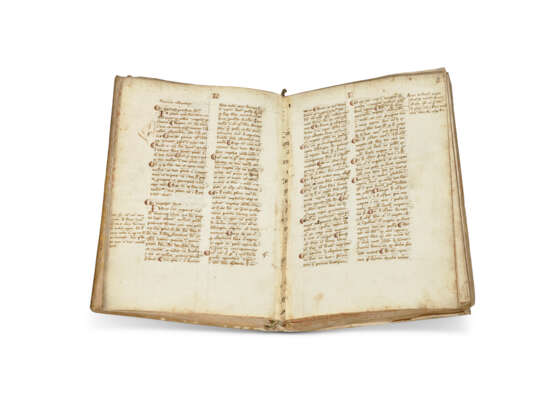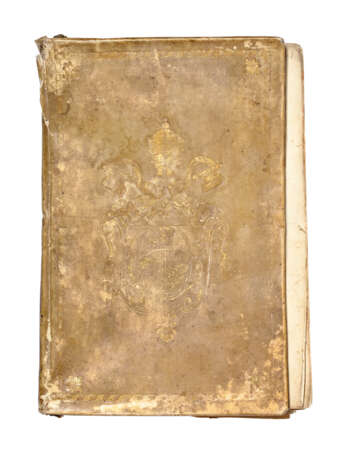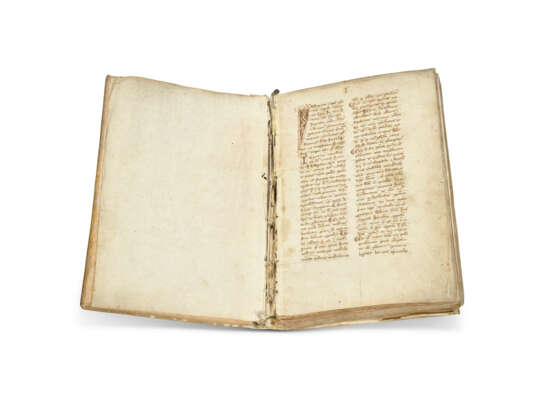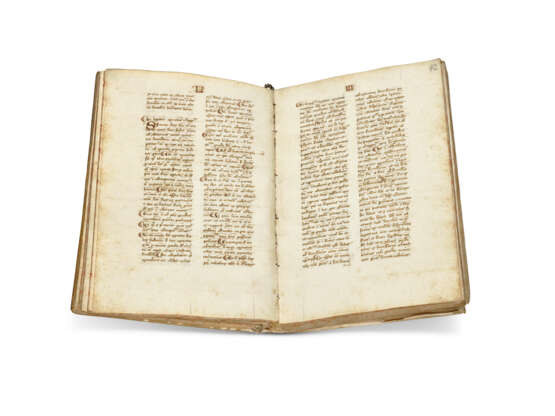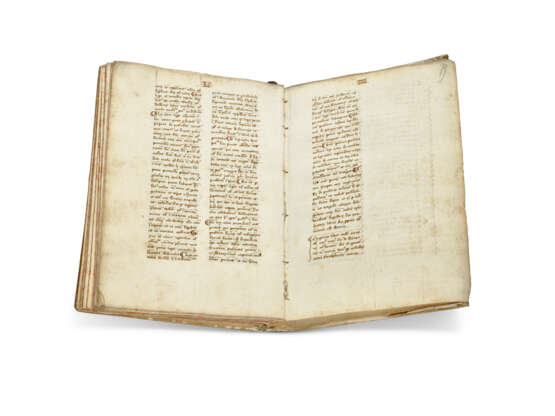ID 1214859
Лот 36 | Pope Pius VI's copy of Justinian
Оценочная стоимость
£ 7 000 – 10 000
Justinian I (482-565), Institutes, and Johannes de Deo (d.1267), Decretum abbreviatum, etc., in Latin, decorated manuscript on paper [Italy], dated 5 February 1430
A precisely dated copy of a standard legal text, later owned by Pope Pius VI.
215 × 145mm. ii (loose) + 88 + ii leaves, with a watermark in the form of a triple mount surmounted by a cross, collation: 1–810, 98, inner and outer bifolia strengthened with strips cut from a vellum manuscript, horizontal catchwords in the the first seven gatherings, frame-ruled in plummet, the ruled space 150 × 90mm, written in fairly cursive Humanistic script in two columns of about 33–34 lines, paraphs and initials in dark red-brown (the textblock detached from the binding and the sewing loose, with some foxing of the edges of some leaves).
Binding:
Binding of Pope Pius VI: vellum over pasteboards, each cover with his gilt arms (a personification of the wind, blowing through lilies, three stars in chief) in a central oval, surrounded by swags and surmounted by the papal tiara and crossed keys, the covers with gilt frame and corner ornaments, the top of the spine inscribed ‘46’ (worn, with the gilt arms somewhat indistinct). In a green cloth-covered box with gilt leather spine title.
Provenance:
(1) The scribe finished writing the book on 5 February 1430: ‘Explicit liber Institutiones anno Mo cccco xxxo. die .v. Februarii ad honorem dei & genitricis eius Marie tociusque cellestis curie triumphantis amen’.
(2) Sporadic 15th-century marginal annotations and frequent 16th(?)-century maniculae.
(3) Pope Pius VI (reigned 1775–99): the binding suggests that this was either his personal properly, or he had it bound as a gift.
(4) Graf Ludwig Paar (1817–1893): sold by Samuel Kende, Vienna, Katalog der reichhaltigen Sammlungen weiland Sr. Excellenz des Herrn Botschafters Grafen Ludwig Paar, 20 February 1896, lot 241; probably remaining in Austria for the next several generations, until consigned with an export licence from Austria and sold at Sotheby’s, 8 December 2009, lot 44; bought by:
(5) The Schøyen Collection, MS 5436.
Content:
The text opens ‘Iustiniani incipit prohemium cupide iuventutit [sic] legum. In nomine domini nostri Yhesu Christe imperator Cesar Flavius Justinianus […] Imperatoriam majestatem non solum armis decoratam […] deo propitio adventura est Amen’, with Books I (f.1), II (f.14v), III (f.39), IV (f.59v), ending at f.79 with a colophon (see Provenance). The main text is followed by a list of contents, with folio numbers (using ‘c’ for carta): ‘Incipiunt rubrice primi libri Institutionum. c.2. De iusticia et iure […] De publicis iudiciis .c.78. Expliciunt rubrice institutionum que quidem sunt nonaginta novem numero. Ad honorem dei.’ (ff.79v–80); notes on the election, confirmation, and consecration of bishops, etc. (f.80v; 81 blank); Johannes de Deo, Decretum abbreviatum: ‘Incipit decretorem abreviatio. Liber decretorum distinguitur in tres partes quarum prima vocatur distinctiones, 2a vocatur cause, 3a de consecratione […] In 5. de confirmacione et ieunio, &c finiantur et finitur.’ (f.81v–87v); lists of the rubrics of the five books of the Decretals of Gregory IX, ‘Rubrice primi libri decretalium. Primus habet trinum Joachimque statuta rescriptum […]’ (ff.87v–88).
The Emperor Justinian tasked a group of jurists to compile a single body of Roman law that could be used throughout the Empire, partly as an expression of its common history, traditions, culture, and language. This body of law, known as the Corpus Iuris Civilis, was composed of four parts: a compilation of authoritative sources, the Digest (compiled in 533); a compilation of law codes, the Code (534); a brief summary of the main principles of law, the Institutes (535); and the Novellae Constitutiones (556), an update of new laws passed after 534. These 6th-century collections were reorganised from the 12th to the 14th centuries into forms more appropriate for teaching, especially at the university of Bologna. The Institutes might appear on its own, as in the present manuscript, or as a part of a larger compilation known as the Parvum Volumen.
| Место происхождения: | Италия, Европа |
|---|---|
| Категория аукционного дома: | Манускрипты Средневековья и Ренессанса, Книги и рукописи |
| Место происхождения: | Италия, Европа |
|---|---|
| Категория аукционного дома: | Манускрипты Средневековья и Ренессанса, Книги и рукописи |
| Адрес торгов |
CHRISTIE'S 8 King Street, St. James's SW1Y 6QT London Великобритания | |
|---|---|---|
| Предосмотр |
| |
| Телефон | +44 (0)20 7839 9060 | |
| Комиссия | see on Website | |
| Условия использования | Условия использования |
